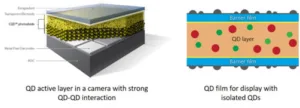At a fundamental level displays have done the same thing for centuries. They convert electricity into light which is then transformed into an image. But let us not forget about the other side of this technology that happens first.

Images must be captured by a camera before we can decide what resolution, color or sound will accompany them. The key function of camera is the polar opposite of a display. Cameras convert photons from the complicated optical world around us into electrons.
Today I’m going to cover an up-and-coming application for quantum dots, not in the display itself, but rather on image capture side – as the photo-sensitive layer in an imaging system.
QD cameras – nothing to do with gamut
I won’t even mention the g-word in this blog (OK, only once). QDs in imaging have nothing to do with color rendering. In fact, when absorbing, QDs absorb broad wavelengths of light, unlike their emissive cousins which emit very pure light.
Perhaps some of you remember the news last year that Apple acquired InVisage, a company working on QD imaging for cell phone cameras? Similar to Apple, InVisage remained super-secretive about what they were working on. According to the InVisage website, there are a number of advantages over the existing silicon imaging system in your cell phone.
- Global shutter which results in less motion blur – this is a product of their circuit and electrode design, not the QD layer
- Thin, efficient photosensitive layer (the QDs)
- High dynamic range. A result of isolating the absorption and signal processing into two separate planes (QDs and Si readout) compared to Si alone
- Tunable absorption from visible to infrared depending on the application
You can see some short movies and images on the InVisage website that show the advantages of this technology compared to traditional Si. Not surprisingly, Apple declined to comment.
Photos of three different imaging technologies highlighting the differences in dynamic range (www.invisage.com)
A newly formed company, SWIR Vision Systems is also making QD imaging systems, but theirs are specifically designed for short-wave infrared wavelengths (hence the name SWIR). The company uses a different flavor of QDs than what we are used to in displays, but their QDs are based on the same physical concept of quantum confined semiconductor nanocrystals (perhaps I’ll leave the quantum confinement discussion for another day). These QDs are sensitive in the infrared region of the electromagnetic spectrum. Our eyes are great at picking up very minor changes in the spectral region between 400-700 nm, but our photoreceptors are no good at wavelengths beyond 700 nm – but that doesn’t mean there isn’t useful information there!
CTO of SWIR Vision Systems, Ethan Klem, says the company is currently targeting industrial customers where the price of the incumbent monolithic InGaAs infrared detectors is too expensive. While very efficient, InGaAs has a number of drawbacks including high cost, and poor resolution which has prevented short-wave IR imaging from penetrating into some price-sensitive markets. Things like monitoring a glass melting process, imaging through plastic bottles, and maritime imaging in hazy environments are among some of the initial applications that SWIR Vision Systems is targeting, and the images are compelling. It’s amazing what our eyes can’t see!
 Comparison of images taken with a visible-sensitive camera compared to a SWIR camera (www.swirvisionsystems.com)
Comparison of images taken with a visible-sensitive camera compared to a SWIR camera (www.swirvisionsystems.com)
Ethan thinks that in the future these QD-IR cameras could be used in a growing number of high tech applications that use infrared photons. From autonomous vehicles to medical imaging, inexpensive & high performance visible-to-IR imaging systems may be an enabling technology that supports advancements across a wide range of industries.
QDs in displays compared to QDs in cameras
Compared to QDs in displays, the function of QD cameras is very different. In displays QDs are dispersed in a polymer absorb blue light and re-emit red or green. No charge is transferred between adjacent QDs. In a camera, a pure QD film (no polymer) absorbs broadband light from the visible to IR and converts those incoming photons to electron-hole pairs (electric current) which are passed along to neighboring QDs. It’s up to the QDs to both convert the incoming photons into electrons and holes, as well as transfer them to an electrode – no easy feat. Another key difference is that QDs in cameras are specifically designed not to re-emit light, but in displays QDs are engineered to emit light very efficiently.
No doubt about it, we have come a long way in how we interact with photons in our daily lives. The pace of advancement is evident today more than ever I would argue, and QDs represent a maturing technology that is finally finding its way out of the lab and into our lives. And we are no where near the end of their potential yet.
Peter Palomaki is the owner and chief scientist at Palomaki Consulting, a firm specializing in helping companies solve big problems at the nanoscale. His utilizes his expertise in quantum dots and materials chemistry to solve challenging problems with clients large and small.

